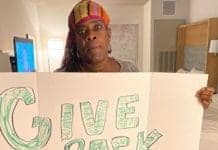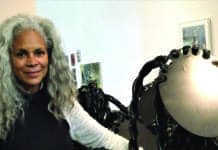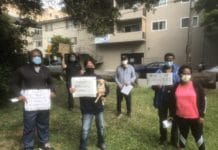by The People’s Minister of Information JR Valrey

I think Oakstop is something that young Black and Brown artists and entrepreuners in the Bay should be aware of. Trevor is looking outside the box for ways to keep some of Oakland’s culture insulated from the wave of gentrification generated by the techie land grab of San Francisco.
For people who are tired of Starbucks and the techies invading your local neighborhoods, this may be a way for us to pull our resources before we all are forced to embark on the plan engineered by former mayor and current Gov. Jerry Brown to put Black and Brown Oakland on a Trail of Tears to Antioch, Sacramento, Tracy and Stockton.
Make it a point to visit Oakstop after you read Trevor Parham’s words about this new idea that could help to preserve Oakland culture in the midst of a physical and cultural invasion that is overtaking us and surrounding areas. Check him out.
M.O.I. JR: Can you talk about how you came up with the idea for Oakstop? Do you have a history in real estate?
Trevor: Sure, I suppose it would first be helpful to state Oakstop’s mission: “Oakstop is a shared working environment, event space and art gallery that fosters collaboration, professional development and economic sustainability for creative entrepreneurs and small businesses.”

Oakstop is located right above the 19th Street BART station and is an ideal location to further develop all of my areas of professional experience. The story for how I came up with Oakstop is a testament to how these different areas of experience converged into one endeavor.
While developing a pop up art gallery in Oakland’s KONO district, I realized how mixed-use creative spaces could both generate interest in vacant properties and provide a valuable brick and mortar resource to artists and local entrepreneurs. I pitched the owner of the building on a plan to use the first floor retail space as a destination for creative enterprise. The plan included several revenue generating functions like shared wifi workspace, creative media services, boutique retail and educational workshops.
The idea was to create value in the community by making use of a first floor retail space in ways that benefit both the property owner and local artists. After four months of improving the space and demonstrating its value through the art gallery function, we were able to lease it to a longer term tenant at full market rate. The creative space essentially sold an unsellable property. It was a mutual win for both the developer and myself.
While managing the art gallery, someone commissioned one of the artists I work with to do a painting for her. She was so pleased with the way that I managed the commission process that she later hired me to provide all of the art consulting for a coworking space she managed in Berkeley called NextSpace.
I brought roughly 12 local artists and 100 pieces of artwork into NextSpace, including a custom mural I created for their largest wall. The NextSpace team was so impressed with how I integrated artwork into their space that they offered to help guide me through the process of launching a coworking space for creatives should I ever choose to. I took the offer seriously and started contemplating other properties, primarily in Oakland.
NextSpace Berkeley opened around the same time that I had started doing more real estate work in Uptown Oakland. I was doing communications strategy and capital development for a Black-owned real estate development firm, and we were working on a major mixed-use arts and retail project, right near the19th Street BART station, intended to revive Oakland’s retail market while also creating jobs in the local community.
I quickly learned how the 19th Street BART station could potentially become the nexus of a major shift in Oakland’s economy. This was even more reason to establish a coworking environment in Uptown Oakland; it would place creatives in the center of an economic boom.
The 19th Street BART station could potentially become the nexus of a major shift in Oakland’s economy. This was even more reason to establish a coworking environment in Uptown Oakland; it would place creatives in the center of an economic boom.
I eventually crossed paths with another developer in Oakland who had some vacant suites in a building right near the 19th Street BART. He wanted offices to occupy a large 4,000-square-foot suite in the building and I pitched him on my original idea for shared workspace and creative enterprise. He liked the idea and encouraged me to push forward with it as he saw how it could also add value to his building and the surrounding community.

M.O.I. JR: Over the last two months, how have people been responding? Who are some of the notable artists who are working with Oakstop?
Trevor: The response to Oakstop has been overwhelmingly positive and heartwarming to say the least. More than anything, people seem to see Oakstop as a needed resource and are appreciative of both the vision and the facility.
Moreover, our visitors and members consistently comment on their comfort with the community and the culture. Apparently Oakstop offers a different vibe than a lot of the other coworking spaces that people have visited, and I think this is especially the case with creative professionals.
The great thing about Oakstop is that we host such a variety of creative professionals, some of whom work in disciplines that are often less notable than say 2-D art, music or entertainment – e.g. sculpture, interior design, video. We also have several artists in those more notable disciplines too, including James Gayles, Jennifer Johns, Kev Choice, Unity Lewis and DJ Aeble Dee.
M.O.I. JR: How do you see Oakstop in relation to the ongoing gentrification in Oakland and in San Francisco?
Trevor: Great question and it requires a comprehensive response; gentrification is a sensitive subject in Oakland these days. Having worked with a Black-owned real estate development firm that often conducts work in response to gentrification in Oakland, I wanted to make sure that Oakstop’s mission, culture and business model were conscious of and could participate in the ongoing dialogue around gentrification.
I’m much more familiar with the current dialogue around gentrification in Oakland – which often includes the idea of people moving from San Francisco to Oakland – so I’ll limit my response to gentrification specifically in Oakland.
Coworking spaces have become increasingly prevalent in the Bay Area, especially in San Francisco. Given that some of the earliest coworking spaces started in San Francisco, a lot the spaces have naturally adopted several elements of San Francisco’s coworking culture, many of which are great for innovation and entrepreneurship.
However, there are elements of San Francisco’s coworking culture that naturally wouldn’t be the most suitable fit for Oakland. I want to make sure that Oakstop’s culture is suitable for Oakland. It’s important that we don’t simply try to replicate San Francisco coworking culture as a means to be profitable and, in turn, end up alienating people from the surrounding community.
Professional development is important for local artists and entrepreneurs so that they can generate more economic stability for themselves and ultimately have a chance at competing for property in the residential or commercial markets … instead of getting pushed out of Oakland.
Oakstop openly welcomes anyone from San Francisco or anywhere else, but it’s important that our work environment caters to the local community first so that it can showcase Oakland’s culture to people visiting from other cities. We don’t want to create a business or work environment in the middle of Uptown Oakland that excludes or ultimately pushes out Oaklanders.
In terms of economics and workforce development – another major aspect of gentrification – we want to provide a space where local entrepreneurs and artists can develop their professional skills, both hard skills and soft skills. Professional development is important for local artists and entrepreneurs so that they can generate more economic stability for themselves and ultimately have a chance at competing for property in the residential or commercial markets … instead of getting pushed out of Oakland.
Property rates in Oakland continue to rise in response to the rising property rates in San Francisco, and as such we are witnessing a migration of gainfully employed people moving from San Francisco to Oakland in search of relatively lower rates. As such, Oakland property owners are able to raise their rates knowing that they can be paid by people crossing the bridge looking for anything lower than what they find in San Francisco.
This is all to say that gentrification is often the result of an underdeveloped local workforce. Oakstop is a destination for workforce development.

As most of us know, just about every business needs an identity and a way to make themselves visible within their market; creatives provide that – at the very least. The creative contributions are often just undervalued when it comes to monetary compensation. This is likely due to both a misperception of their value and an actual dearth of professional skills.
If we continue to develop our creative workforce, we’ll reach a point where they’re properly compensated for their value and are eventually able to start their own small businesses. An increase in creative small businesses can provide even more jobs in the local economy within an industry that is particularly attractive to youth and young adults, 18-25, a demographic facing some of the highest rates of underemployment.
When our city is able to develop its workforce, hire more people from its local community and pay them with competitive wages, we will be on our way to solving the gentrification equation. Oakstop plans to be one of many groups in Oakland facilitating that solution.
M.O.I. JR: How do people join Oakstop? And what do they get for their membership?
Trevor: People can join Oakstop by simply purchasing day passes or signing up for monthly membership, which can be purchased on three-, six- or 12-month terms. Month to month terms area also available. All Oakstop members receive access to our community spaces plus discounts on event space, conference space and workshops. Depending on their level of membership, they can also get private offices, dedicated desk and storage space, access to our in-house photo and video production resources, and private consulting on the creative needs for their business.
We need to create new, better and more lucrative jobs for people in Oakland and much of that can be done within the creative industry. When our city is able to develop its workforce, hire more people from its local community and pay them with competitive wages, we will be on our way to solving the gentrification equation. Oakstop plans to be one of many groups in Oakland facilitating that solution.
Beyond the material benefits, all Oakstop members also get access to a dynamic community of creatives, activists and entrepreneurs. Just being in the space on a consistent basis creates so many invaluable opportunities to collaborate and grow your business.
M.O.I. JR: How has the city responded? Has there been any competition?
Trevor: To be clear, the City of Oakland and city officials have yet to formally respond to Oakstop – if that’s what you were asking – though I feel we will get a response from the City of Oakland soon. However, the people and businesses in Oakland have responded very positively to Oakstop.
Having already established relationships with the founders of many of the other coworking spaces in Oakland before I started Oakstop, I’ve really experienced more collaboration than competition within the coworking industry in particular. There is such a need for these coworking spaces in Oakland, and there still don’t seem to be enough here to meet that need.
There’s no reason for competition. If anything, we’ll be working on ways to cross-pollinate our businesses, refer potential members to each other and increase the overall awareness of the value of coworking in Oakland.
M.O.I. JR: When Oakstop is operating at full capacity, how will it look different from what you have today?
Trevor: When Oakstop has even more members and is operating at a fuller capacity, it will likely just transform to increase its capacity … so in many ways it’s hard to predict exactly what it will look like. Much of that is up to the needs of its members and community. However, there are already things that I know will be different in the near future as we continue to grow our community of members.
Oakstop is intended to have more workshops, equipment resources, service offerings and regularly scheduled events. With more members – or at least enough to fill our current 4,000-square-foot space – we can offer more resources and services and we’ll be able to accomplish more as a community.
Ideally, we’ll be able to replicate Oakstop to other locations within and outside of Oakland. So in many ways when Oakstop is at full capacity, it will have multiple locations across multiple neighborhoods in the Bay Area.
M.O.I. JR: How can people get in touch with you?
Trevor: People can get in touch with me via my email, trevor@oakstop.com, or via our online properties: www.oakstop.com, facebook.com/oakstop, twitter.com/oakstop and instagram.com/oakstop.
The People’s Minister of Information JR Valrey is associate editor of the Bay View, author of “Block Reportin’” and the newly released “Unfinished Business: Block Reportin’ 2” and filmmaker of “Operation Small Axe” and “Block Reportin’ 101,” available, along with many more interviews, at www.blockreportradio.com. He can be reached atblockreportradio@gmail.com.

 Store
Store












